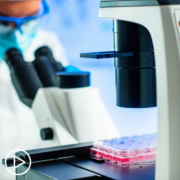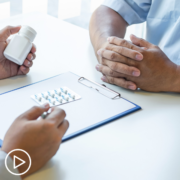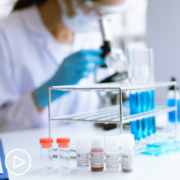Stem Cell Transplant for AML | What Patients Should Know
Stem Cell Transplant for AML | What Patients Should Know from Patient Empowerment Network on Vimeo.
When is stem cell transplant an option for AML care? AML specialist Dr. Alice Mims discusses who this procedure is most appropriate for and how patients are monitored after transplant. Dr. Mims also addresses common issues following stem cell transplant, including joint pain.
Dr. Alice Mims is a hematologist specializing in acute and chronic myeloid conditions. Dr. Mims serves as the Acute Leukemia Clinical Research Director at The Ohio State University Comprehensive Cancer Center – James. Learn more about Dr. Mims.
Related Resources:

|

|

Thriving With AML | Tips and Support for Navigating Treatment |
Transcript:
Katherine Banwell:
Janet wants to know what factors enable a patient to achieve and continue in remission if they are not able to achieve stem cell transplant due to age restrictions.
Dr. Alice Mims:
So, I think first and foremost, I think it’s very important that there — that patients are aware that there shouldn’t be just strict, stringent cutoffs of age as a requirement for stem cell transplant.
And really, there’s a lot of research going on that we should take into account. Physiological age, and there are ways to measure that just to be sure that stem cell transplant really is not an option. And for patients who stem cell transplant is not an option, I think as we talked about earlier, so there can still be really great treatments that can get patients into remission and ongoing therapies with dosing adjustments again to decrease toxicity and improve quality of life and thinking about things like maintenance therapy as appropriate.
Katherine Banwell:
What are the age restrictions, and why are they there?
Dr. Alice Mims:
So, sometimes you will hear age 75. Really, no one above age 75 should move forward with transplant. And that’s based off of past data where they’ve explored transplant and seen increased toxicity. And from transplant in itself, increased side effects, increased risk of early mortality. And so, I do think it’s important to take the patient as a whole into consideration because again, you could have someone who’s 77 who may be running marathons, and in great shape, and not a lot of other healthcare issues, who may still do really well with treatment. And so, I think that’s – really needs to be taken in account, really the overall picture of health for the patient before making…
Katherine Banwell:
So, the…
Dr. Alice Mims:
…just a firm cutoff.
Katherine Banwell:
Right. Okay. So, it’s not cut and dry.
Dr. Alice Mims:
Exactly.
Katherine Banwell:
If you’re 75 or older, then you definitely can’t have stem cell transplant.
Dr. Alice Mims:
That’s correct.
Katherine Banwell:
Then you’re looking at everyone individually.
Dr. Alice Mims:
Yeah. So, it really should be looked at. And I still have some patients who will come to me and say, “Oh, I was told I’m 68 years old, I’m not a candidate.” And that always makes me take a step back. And then we kind of have to have that discussion again. And they may still not be a good candidate based off of other comorbidities or healthcare issues, but it shouldn’t just be a number rules you out for having that as an option.
Katherine Banwell:
Good to know. We received this question from Carl, “What does treatment look like following transplant? And what are doctors looking for when monitoring through blood tests?”
Dr. Alice Mims:
Sure. So, after transplant, the first three months is pretty intensive of being seen very frequently at your transplant center twice to once a week. You’re also on immunosuppressive medications to try to help prevent issues like graft-versus-host disease, which can be a complication from transplant.
And then over time if you’re doing well, we try to start tapering off those immunosuppressive regimens to see if you can tolerate that. And what I say to most of my patients for – who are undergoing transplant, it can take some time to really feel back to being yourself. It can take six months, it can take a year or longer. And sometimes your normal is a new normal based off of how you do and the side effects of the transplant in itself. So, you may not go back to if you’re here before transplant and before your diagnosis, it may be that this is your new normal. Just so people can be prepared and know what they’re signing up for.
Katherine Banwell:
And with the blood testing, what are you looking for when you’re monitoring a patient?
Dr. Alice Mims:
Sure. There are a few different things that we’re looking for when monitoring patients. So, one, making sure that the stem cells or the graft from the donor are recovering.
You want to see that blood counts, levels of white blood cells, red blood cells, platelets are getting to normal levels. You’re also assessing and making sure you’re not seeing signs of relapse. You’re checking levels of donor cells versus the patient cells within the stem cell — sorry, within the stem cell compartments. And so, we’re taking all of those into account as well as checking organ function and making sure there’s no signs of potential graft-versus-host disease as well.
Katherine Banwell:
Ryan wants to know, “I’m a year-and-a-half post-transplant, how can you tell if the aches and pains in your joints are normal aging, host versusgraft disease, the AML returning, or even something else?”
Dr. Alice Mims:
So, I think that’s also a difficult question to answer, because it really is patient-dependent. And so, I think if you’re having new joint aches or pains, it’s always important to reach out to your transplant team to make sure that – it could be any of the above.
And so you’re doing the appropriate workup with lab work, imaging, things that would be appropriate, or seeing certain specialists. Maybe orthopedist if needed because it could be I’d say less likely leukemic relapse, but still want to be sure. But it could be definitely complications from GVHD, or there are some joint issues that can evolve post-transplant, especially for people who are on long-term immunosuppressant medications. Or it could be the normal effects of aging. So, it’s always good to have that reassurance.










